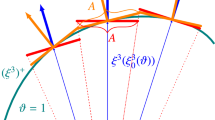Abstract
A numerical procedure based on the boundary-integral equation method, is formulated using the fundamental solution (Green's function) for an infinite anisotropic plate containing an exact crack. The boundary-integral equation developed can be solved numerically for the mode 1 and mode 2 stress intensity factors by approximating boundary data on the surface of an arbitrary body, excluding the crack surface. Thus the efficiency and generality of the boundary-integral equation method and the precision of exact crack model analyses are combined in a direct manner. The numerical results reported herein are as accurate as previously published isotropic results. The effects of material anisotropy are reported for center and double-edge cracked geometries. A path independent integral for obtaining mode 1 and mode 2 stress intensity factors directly for arbitrary loading is reported.
Résumé
Une procédure numérique, basée sur la méthode d'équation d'intégrales aux limites, est exposée, en utilisant la solution fondamentale (fonction de Green) pour le cas d'une plaque infinie et anisotrope comportant une fissure bien identifiée. L'équation d'intégrales aux limites développées peut être solutionnée numériquement pour les facteurs d'intensité de contraintes de mode 1 et mode 2 en disposant de manière approchée les limites à la surface d'un corps arbitraire à l'exclusion de la surface de la fissure. De la sorte, l'efficacité et le caractère général de la méthode d'équation d'intégrales aux limites se trouvent combinés de manière directe avec la précision des analyses des modèles de fissures bien identifiées. Les résultats numériques donnés dans l'article ont la même précision que ceux publiés précédemment, et relatifs à des conditions isotropes. Les effets de l'anisotropie du matériau sont rapportés dans le cas de géométrie à fissures centrales ou à doubles fissures de bord. Une intégrale indépendante du parcours est donnée pour obtenir directement les facteurs d'intensité d'entaille de mode 1 et de mode 2 sous des conditions arbitraires de mise en charge.
Zusammenfassung
Ein numerisches Verfahren begründet auf das Verfahren der Grenzintegralgleichung wird aufgestellt für eine unendliche unisotropische Platte mit einem festgestellten Riß, durch Gebrauch einer grundlegenden Lösung (Greensgleichung). Die aufgestellte Grenzintegralgleichung kann für den ersten und den zweiten Fall der Spannungsintensitätsfaktoren gelöst werden durch Annäherung von Grenzbedingungen auf der Oberfläche von einem beliebigen Körper ausschließlich der Rißfläche. So wird die Wirksamkeit und die Universalität der Grenzintegralgleichungsmethode und die Genauigkeit des genauen Rißmodells unmittelbar verbunden. Die hier angegebenen Rechenresultate sind genau so wie die früher veröffentlichten isotropische Ergebnisse. Der Einfluss von Materialunisotropie sind für mittel und doppel Randrißgeometrie gegeben. Ein Weg durch unabhängige Integralgleichung zur Lösung des ersten und zweiten Grades der Spannungsintensitätsfaktoren wird für beliebige Belastung gegeben.
Similar content being viewed by others
References
F. J. Rizzo, An Integral Equation Approach to Boundary Value Problems of Classical Elastostatics, Quarterly of Applied Mathematics, 25 (1967) 83–95.
T. A. Cruse and J. L. Swedlow, Interactive Program for Analysis and Design Problems in Advanced Composites Technology, AFML-TR-71-268, December (1971).
T. A. Cruse and W. Van Buren, Three-Dimensional Elastic Stress Analysis of a Fracture Specimen with an Edge Crack, International Journal of Fracture Mechanics, 7 (1971) 1–16.
T. A. Cruse, Application of the Boundary-Integral Equation Method to Three Dimensional Stress Analysis, Computers and Structures, 3 (1973) 509–527.
T. A. Cruse, Numerical Evaluation of Elastic Stress Intensity Factors by the Boundary-Integral Equation Method, pp. 153–170 of The surface Crack: Physical and Computational Solutions, Ed. by J. L. Swedlow, American Society of Mechanical Engineers, New York (1972).
O. L. Bowie and C. E. Freese, Central Crack in Plane Orthotropic Rectangular Sheet, International Journal of Fracture Mechanics, 8, (1972) 49–58.
M. D. Snyder and T. A. Cruse, Crack Tip Stress Intensity Factors in Finite Anisotropic Plates, Air Force Materials Laboratory Technical Report AFML-TR-73-209 (1973).
F.J. Rizzo and D.J. Shippey, A Method for Stress Determination in Plane Anisotropic Elastic Bodies, Journal of Composite Materials, 4 (1970) 36–61.
W. F. Brown and J. E. Srawley, Plane Strain Crack Toughness Testing of High Strength Metallic Materials, ASTM STP 410, American Society for Testing and Materials, Philadephia (1966).
S. G. Leknitskii, Theory of Elasticity of an Anisotropic Elastic Body, Holden Day, Inc., (1963).
Author information
Authors and Affiliations
Rights and permissions
About this article
Cite this article
Snyder, M.D., Cruse, T.A. Boundary-integral equation analysis of cracked anisotropic plates. Int J Fract 11, 315–328 (1975). https://doi.org/10.1007/BF00038898
Received:
Revised:
Issue Date:
DOI: https://doi.org/10.1007/BF00038898




